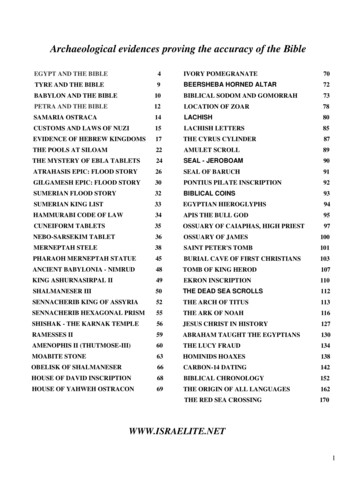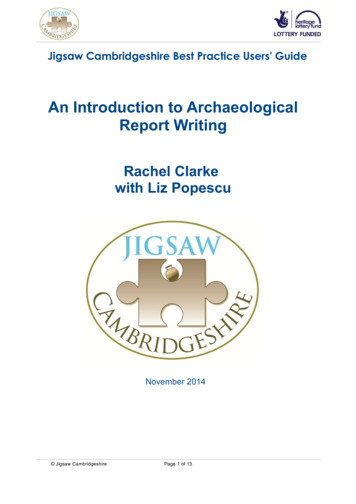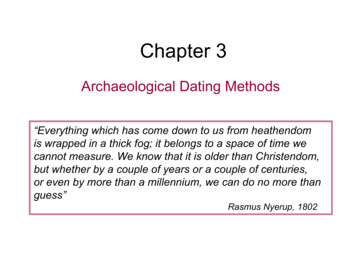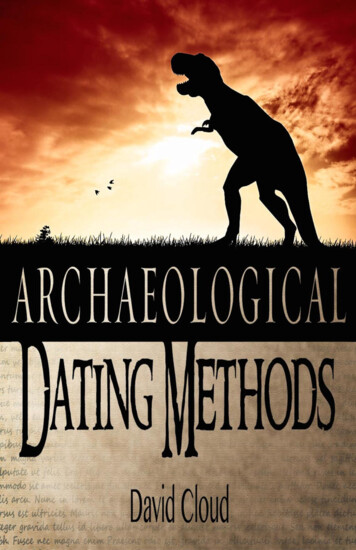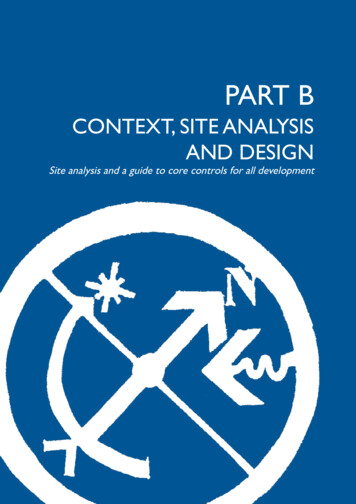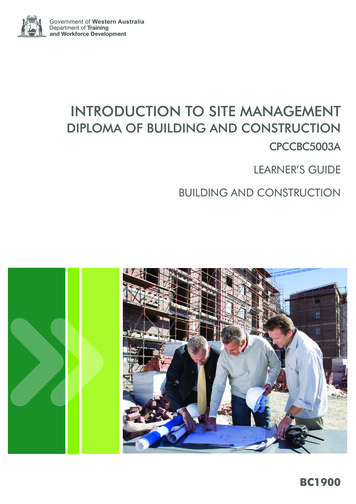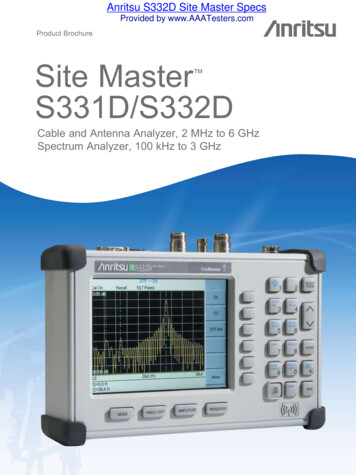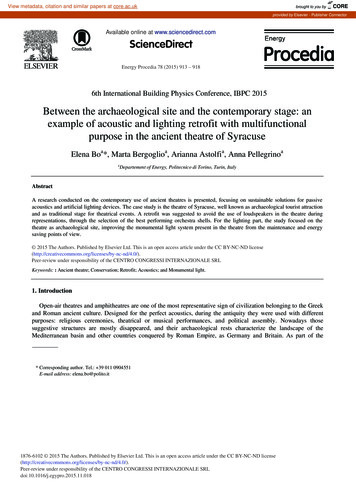
Transcription
View metadata, citation and similar papers at core.ac.ukbrought to you byCOREprovided by Elsevier - Publisher ConnectorAvailable online at www.sciencedirect.comScienceDirectEnergy Procedia 78 (2015) 913 – 9186th International Building Physics Conference, IBPC 2015Between the archaeological site and the contemporary stage: anexample of acoustic and lighting retrofit with multifunctionalpurpose in the ancient theatre of SyracuseElena Boa*, Marta Bergoglioa, Arianna Astolfia, Anna PellegrinoaaDepartement of Energy, Politecnico di Torino, Turin, ItalyAbstractA research conducted on the contemporary use of ancient theatres is presented, focusing on sustainable solutions for passiveacoustics and artificial lighting devices. The case study is the theatre of Syracuse, well known as archaeological tourist attractionand as traditional stage for theatrical events. A retrofit was suggested to avoid the use of loudspeakers in the theatre duringrepresentations, through the selection of the best performing orchestra shells. For the lighting part, the study focused on thetheatre as archaeological site, improving the monumental light system present in the theatre from the maintenance and energysaving points of view. Publishedby byElsevierLtd.Ltd.This is an open access article under the CC BY-NC-ND license eer-review under responsibility of the CENTRO CONGRESSI INTERNAZIONALE SRL.Peer-review under responsibility of the CENTRO CONGRESSI INTERNAZIONALE SRLKeywords: : Ancient theatre; Conservation; Retrofit; Acoustics; and Monumental light.1. IntroductionOpen-air theatres and amphitheatres are one of the most representative sign of civilization belonging to the Greekand Roman ancient culture. Designed for the perfect acoustics, during the antiquity they were used with differentpurposes: religious ceremonies, theatrical or musical performances, and political assembly. Nowadays thosesuggestive structures are mostly disappeared, and their archaeological rests characterize the landscape of theMediterranean basin and other countries conquered by Roman Empire, as Germany and Britain. As part of the* Corresponding author. Tel.: 39 011 0904551E-mail address: elena.bo@polito.it1876-6102 2015 The Authors. Published by Elsevier Ltd. This is an open access article under the CC BY-NC-ND nd/4.0/).Peer-review under responsibility of the CENTRO CONGRESSI INTERNAZIONALE SRLdoi:10.1016/j.egypro.2015.11.018
914Elena Bo et al. / Energy Procedia 78 (2015) 913 – 918cultural and architectural global heritage, the ancient theatres are subject to strict controls in order to preserve themfor the future generations: several international Charters and laws were developed during the last years, promoted byUNESCO, with the aim of an international common model both for conservation and modern usage. Many of themrepresent a touristic attraction, with an intense flow of visitors during the day, but also during the night. Particularly,always more contemporary artistic festivals take place in those ancient structures, indeed in the best conservedtheatres. The introduction inside the archaeological areas of temporary scenic structures and modern devices(electro-acoustic and artificial lighting systems) represents a potential risk to which the theatres are constantlysubjected. As suggested by the recent Syracuse Charter “for the conservation, fruition and management of theancient theatrical architecture” [1], the definition of guidelines for the contemporary use of the ancient theatresbecomes necessary, but unfortunately, in the practical experience this target has not been reached yet, especially inthe technical and energetic domain (acoustics and lighting).The ancient theatre of Syracuse, the south of Italy, was chosen as case study to evaluate different sustainablesolutions, finalised to the acoustic and lighting retrofit. Firstly, it was necessary to conduct an investigation on theconditions of usage of the theatre, during performances and not. Subsequently, on its specific characteristics, somestrategies of intervention were defined, as development of previous analysis concerning both light and sound [2].From the acoustic point of view, the research focused on an objective and subjective analysis: different types ofacoustical measurements were performed in occasion of the last edition of classical plays organized by INDA(2014); moreover, a survey on the acoustic perceptions was distributed in form of questionnaires to spectators andactors, pointing out a controversial general opinion about the use of loudspeakers inside the theatre. The solutionproposed by the authors refers to previous researches [3] that revealed the significance of scenery design for theacoustics of open-air theatres. By appropriately designing scenery, useful early reflections can be increased, andsound can be distributed more evenly in the theatre, without using electro-acoustics devices. From the lighting pointof view, the investigation concerned the monumental lighting system. Designed in 2008 with the intention oforganizing tourist visits of the theatre during the night, unfortunately it is not in use anymore. Its analysis revealedthat the technologies chosen at the time, mostly halogen lamps, could be reasonably substituted with moreinnovative solutions (i.e. LEDs), to guarantee energy saving, costs limitation and easier maintenance. This simpleretrofit intervention could be interesting to suppose a rehabilitation of the lighting system today.2. The Greek theatre of Syracuse: actual conditionsThe theatre of Syracuse dates the V century B.C. The structure as it appears today is similar to the Roman type,even though the theatre was conceived in the Greek period, changing over time. The part that survived until todayshows the cavea (where the audience sits) with a diameter of around 105 m (from the original 143 m at its maximumextension), that expands radially around the orchestra in a plane semi-circle of 29 m diameter located in front of thebuilding stage (or scaena frons) not anymore preserved. Since 1914 INDA (Istituto Nazionale Dramma Antico)organizes every summer a festival on the ancient drama, giving back the original function to the survived ruins ofthe theatrical building.2.1. Acoustical measurements on-siteTwo types of acoustical measurement were carried out in the theatre in unoccupied condition: A-weightedbackground noise level (BNL) and speech sound pressure level (SPL). The instrument used for the analyses,provided by the Politecnico di Torino, Department of Energy, was a calibrated sound level meter (Bruel & Kjaer,type 2222). Background noise is mainly due to surrounding nature and traffic from a road at about 60 m under theorchestra. The BNL is based on measurements on three microphone positions, two inside the cavea and one in theorchestra. Ten minutes long measurements were taken in each position, revealing constant BNLs. The measurementof SPL involved an expert actor as a source: the task requested was a 1 min long speech with and without the aid ofloudspeaker system, keeping the same vocal effort. The measurements referred to 5 receiver positions inside thecavea, while the source position was at the centre of the orchestra. Figure 1 shows the measured overall A-weightedBNL and SPL. For corresponding receiver positions (3 and 4) it was possible to calculate A-weighted speech-signal-
Elena Bo et al. / Energy Procedia 78 (2015) 913 – 918to-background-noise ratio (SNR), which represents an indicator for the intelligibility inside the theatre (Fig. 2).Higher values than 10 dB could be considered as fair for speech intelligibility [4].Fig. 1. Overall A-weighted background noise levels and speech soundpressure levels dB(A), unoccupied condition. Sources in red.Fig. 2. Speech-signal-to-background-noise ratio dB with and withoutloudspeakers2.2. Survey on acoustic perceptions (audience and actors)A survey on acoustic perceptions was conducted in the ancient theatre of Syracuse during 4 days of the last cycleof representations (14th-18th May 2014): it involved 42 participants from the audience and 39 actors. Thequestionnaires were distributed at the end of the plays in order to collect subjective opinions on different acousticalaspects; e.g. it was requested to quantify the quality of the sound, to indicate possible disturbing factors or to expressappreciation or not on the use of microphones. Subsequently the answers, rated on 5-points grading scales, wereanalyzed on the basis of statistical methods; the most interesting results are resumed in Table 1.Table 1. Results of the survey on the acoustic perception in the Greek theatre of SyracuseQueryCavea (42 Spectators)Orchestra (39 Actors)Mainly perceived nuisanceBackground NoiseLow VolumeHighest level of nuisanceBackground NoiseLow ClarityMainly perceived noiseCar TrafficChurch BellsContrary to microphone use26%49%The survey stressed the need to control background noises, although the measurements revealed quite low levels.Moreover, the use of the actual electro-acoustic system could represent a disadvantage for the actors, since it is notdesigned for the propagation of the sound in the orchestra area.3. Acoustics applied to the scenic designOn the basis of the analysis of the acoustic conditions of the theatre of Syracuse, and following the indicationsreported by [1], an orchestra shell was evaluated as solution for a better distribution of the sound in the wholetheatre during the performances. Since the target was to improve the original acoustical apparatus without limitingthe scenic design, the orchestra shell was conceived as a minimum interventum and composed by modular elements.The exploration of the different variants was performed by means of computer-based simulations. All simulationswere done in Odeon version 12.1, a geometrical acoustic software based on a hybrid calculation method thatcombines two classical methods – the Image Source Method (ISM) and the Ray-Tracing Method (RTM). In order tocharacterize the acoustics of the theatre, the criteria defined in the ISO 3382-1 standard were used [5].915
916Elena Bo et al. / Energy Procedia 78 (2015) 913 – 9183.1. General settings and preliminary acoustical analysisA preliminary analysis was based on the Sound Strength (G) by using an omnidirectional source, conducted toexplore differences in acoustic conditions, arising from the use of different materials or source positions of ahypothesized basic scenery element in the theatre (a wall). Previous researches [6] demonstrated that G is a moresuitable parameter to characterize the acoustics of an open-air space than Reverberation Time (RT). As shown inFigure 3, 57 receivers were distributed in the model on the five main axes of the cavea (central, diagonals andlaterals), starting from the centre of the orchestra. Height of each receiver is 1.2 m; source S is located in theorchestra, 1.5 m high, in different positions (S1, S2).Fig. 3. (a) Layout of sources and receivers’ positions in the computer model; (b) Odeon visualizationEmpty theatre model has already been calibrated [2]; simulations were run in occupied conditions. Subsequently,a series of different alternatives were analysed by modifying the characteristics of the source and the materials; thisallowed to define some fundamental statements, resumed as follows:x Presence of the scenery: it is registered an increase of the G around 2 dB for last row positions with the source inS1 respect to without scenery condition. The presence of a general architectural element evokes reflections thatenhance the Sound Strength.x Material of the scenery: good results are achieved with wood, plasterboard and plexiglass; any material could bepotentially used, provided that its mass per unit area should be at least 15-20 kg/m2.x Scattering: different scattering coefficients (0.1 - 0.7) seem not affect the results from the point of view of the G.3.2. Simulations on modular orchestra shellsThree principal modular elements were identified: I. central body; II. lateral wings; III. upper panel. Differentversions for each component were defined through geometrical acoustics and simulated using both omnidirectionaland directional sources, in order to evaluate music and speech, respectively. Following a methodology alreadyexperimented in [2], in case of omnidirectional source the elements were estimated by means of Sound Strength (G),to assess the reinforcement of the propagation of the sound, Clarity (C80), to evaluate the possibility of execution ofother kind of performances; SPL and C50 were analysed in case of directional source with raised human voicefrequency spectrum. Echo Criterion (EC) by Dietsch and Kraak [7] was also considered in order to detect potentialecho problems at low frequencies, typical in ancient theatres [8]. Figure 4 shows a resume of the elements analysed.Best results were achieved with Fan Wall (FW) both for speech and music. Although the similar shape,simulations with lateral wings did not give more satisfying results than FW. Upper panel resulted useless for thegreat dimensions of the theatre. For sake of easier comprehension the following discussion in detail of the mostinteresting results will refer only to central body simulations.
Elena Bo et al. / Energy Procedia 78 (2015) 913 – 918Fig. 4. Simulated versions of modular orchestra shellsLogarithmic regression curves related to G values simulated with omnidirectional source in position S2 arereported in Figure 5. With FW the sound propagation improves both in orchestra and cavea with regular trend,reaching an improvement of 5 dB in last positions. C80 reported in Figure 6 is calculated with omnidirectional sourcein central position S1, to simulate a musical ensemble. Results obtained from FW are closer to the typical range ofC80 indicated in [5], referred to closed spaces, 5 dB C80 -5 dB. In Figure 7 best results for echo at lowfrequencies (125 Hz) were obtained with directive source in position S2, even if the echo phenomena is present inlateral areas and last central rows (EC 1).Fig. 5. Simulated G0.5-1kHz logarithmicregression curves, omnidirectional source S2.Fig. 6. Simulated C80 0.5-1kHz logarithmicregression curves, omnidirectional source S1.Fig. 7. Simulated EC map at 125 Hz, directivesource S2.4. Retrofit of the monumental lighting systemThe monumental lighting system of the theatre of Syracuse was completed in 2008. The idea, developed by theItalian architect F. Panzera was to accompany, with light, the guided itinerary from the orchestra ascending to thetop of the theatre. The analysis of the project revealed that the installed luminaires mainly used halogen lamps,typically characterized by short average lifetime and low luminous efficacy. The estimation of the overall power ofthe existing lighting system corresponds to 7 kW. Due to high costs of management and maintenance, the lightingsystem is actually not in use. In this work the potential of a lighting retrofit intervention was verified: withoutchanging the concept of the project, the benefits of substituting halogen lamps with LED equivalent solutions wasassessed. In Figure 8 the luminaires in use and the corresponding lamps, in actual condition and in a hypotheticretrofit are shown. With respect to the performance of existing lamps, LED sources give benefits in terms of energyconsumptions and maintenance costs. With the retrofit solution proposed in Figure 8 the overall power of the917
918Elena Bo et al. / Energy Procedia 78 (2015) 913 – 918lighting plant would be reduced to approximately 1.5 kW. It should be noticed that the luminous flux of the LEDsources is slightly lower then the one of the existing halogen lamps.Fig. 8. Luminaires and lamps characteristics [9 - 10], comparison between actual condition and hypothetic retrofit5. ConclusionsThis article presented acoustical and lighting solutions for the sustainable contemporary usage of ancienttheatres. Acoustically, the aim was to avoid the use of the loudspeakers during performances through an orchestrashell that could be hidden in the scenery. It was demonstrated that complex scenic schematisations are achieved byusing the results of the acoustic simulation of generic categories. In particular, positive effects were obtained withthe Fan Wall, both for music and speech conditions. The lighting analysis is concerned with the lighting systemconceived for nocturnal fruition of the archaeological area. At present the system is not in use due to highmaintenance costs but with new lighting technologies (LEDs) the economical sustainability of the system can beobtained, as demonstrated with the retrofit hypothesis presented in this study.References[1] Syracuse Charter, for the conservation, the fruition and the management of the ancient theatrical architecture, in: Proceedings of IIInternational Conference Ancient Theatres in the Mediterrean Area. October 13-17, 2004.[2] Bo E, Astolfi A, Pellegrino A, Pelegrin-Garcia D, Puglisi G, Shtrepi L, Rychtarikova M. The modern use of ancient theatres related toacoustic and lighting requirements: stage design guidelines fort he Greek theatre of Syracuse, Energy and Buildings, 2015.[3] Chourmouziadou K, Kang J. Acoustic evolution of ancient theatres and the effects of scenery, in: B.N. Weiss (Ed.), New Research onAcoustics, Nova Science Publishers, Inc., New York, 2008[4] ISO 9921 Ergonomics – Assessment of speech communication[5] ISO 3382-1 Acoustics – Measurements of room acoustic parameters – Part 1: Performance spaces.[6] Mo F, Wang J. The conventional RT is not applicable for testing the acoustical quality of unroofed theatres. Building Acoustics Volume 20,Number 1, 81-86, 2013.[7] Dietsch L, Kraak W. Ein objektives Kriterium zur Erfassung von Echostörungen bei Musik-und Sprachdarbietungen. Acustica 60, 1986[8] Rindel JH. Echo problems in ancient theatres and a comment to the “sounding vessels” described by Vitruvius. Proc. The acoustics of ancienttheatres Conference, Patras, 2011[9] http://www.lighting.philips.com/[10] http://www.osram.com/osram com/
acoustics and artificial lighting devices. The case study is the theatre of Syracuse, well known as archaeological tourist attraction and as traditional stage for theatrical events. A retrofit was suggested to avoid the use of loudspeakers in the theatre during representations, throu



